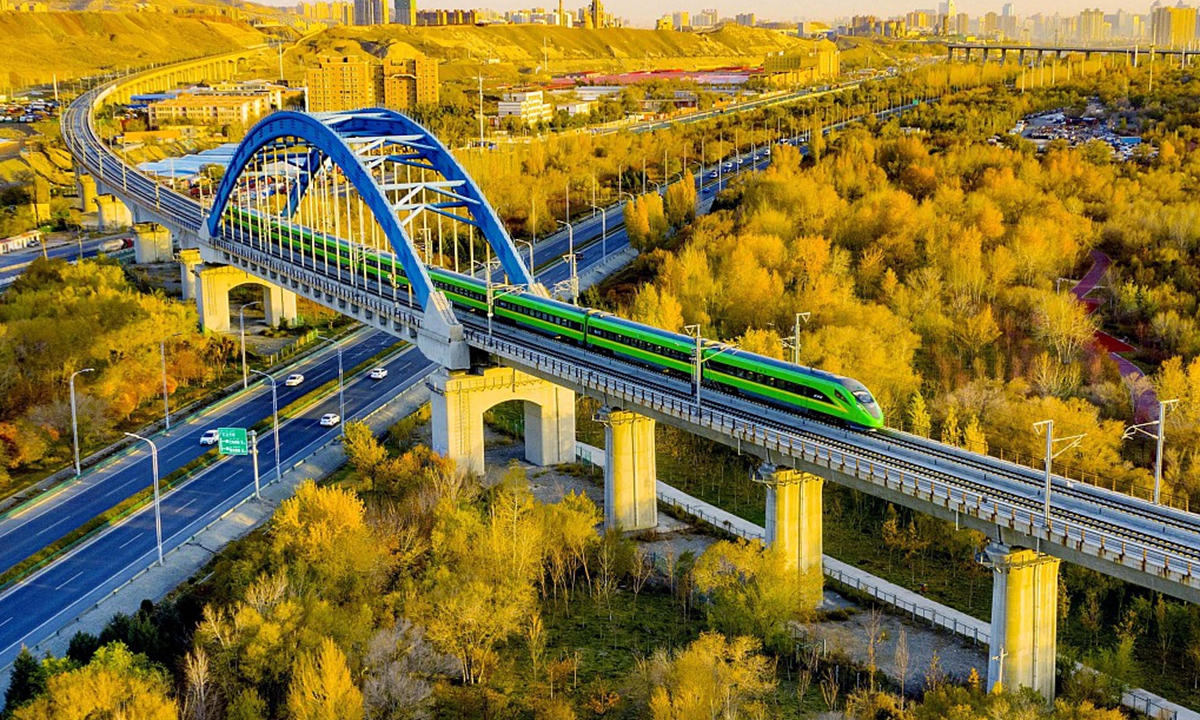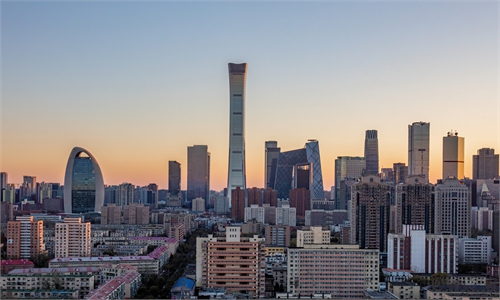
GDP Photo:VCG
China's economy has braved a series of challenges posed by domestic COVID-19 outbreaks and a worsening global environment, posting 2.5 percent year-on-year growth in the first half of 2022, official data showed on Friday.
The expansion of the world's second-largest economy is fueled by a quick recovery in economic activities after outbreaks in major cities were effectively reined in under the country's dynamic zero-COVID strategy and the efficient execution of a slew of pro-growth measures, analysts pointed out.
China's GDP growth, though slowing down from the first quarter largely because of the impact of COVID-19, was mostly in line with market expectations and offers a bright light for the global economy that is mired in a series of troubles, ranging from the pandemic to the Russia-Ukraine conflict to looming economic crises in many countries around the world, including the US, experts said.
In the first half of the year, China’s GDP grew 2.5 percent year-on-year to 56.3 trillion yuan ($8.3 trillion), the National Bureau of Statistics (NBS) said on Friday. In the second quarter of 2022, when the country faced severe COVID-19 outbreaks, GDP grew 0.4 percent year-on-year, the slowest pace since the outbreak in 2020, as compared with a 4.8 percent in the first quarter of the year.
Fu Linghui, a spokesperson for the NBS, said on Friday that the effects of a series of economic stabilization policies are clear, while China's economy has overcome the negative impact of unexpected factors to show a stabilizing and improving trend. In particular, China has achieved positive economic growth in the second quarter and stabilized the economic situation. This is not an easy milestone to have achieved.
The downward pressure on China's economy increased significantly in the second quarter due to a surge of COVID-19 in major Chinese cities, especially its economic hub Shanghai, Cong Yi, professor at the Tianjin University of Finance and Economics, told the Global Times on Friday.
"However, the positive growth in Q2 as a result of a strong rebound in June has indicated the resilience of the Chinese economy to quickly recover from the epidemic shock," Cong said.
Major June macroeconomic data also pointed to a strong rebound of the economy after China emerged from the worst outbreak of the virus since early 2020, with an accelerated recovery in industrial production and improved consumer confidence.
The value-added industrial output of major industrial enterprises rose 3.4 percent year-on-year in the first half of the year. It grew 0.7 percent year-on-year in the second quarter, on par with the growth in May. The growth quickened in June to 3.4 percent, 3.2 percentage points faster than in May.
"The rebound in June was largely due to the fundamentals of China's economy and the stability of China's production system. Once we can get production back in order an economic rebound will follow," Cong said.
Retail sales, a main gauge of consumption, dropped by 4.6 percent in Q2, narrowing the gap from a slide of 6.7 percent in May, according to data from the NBS. It grew 3.1 percent year-on-year in June.
The rebound of consumption comes after both central and local governments introduced measures to boost consumption, especially the stimulus on the automobile sector, Cong said.
China produced 2.499 million cars and sold 2.502 million units in June, up 28.2 percent and 23.8 percent year-on-year respectively, according to data released by the China Association of Automobile Manufacturers on Monday.
Fixed-asset investment, an important pillar for economic growth, also grew 6.1 percent in the first half of the year. It quickened its growth in May and June, posting 4.6 percent and 5.6 percent growth, compared with 1.8 percent growth in April.
Fixed-assets investment gained pace as a result of the accelerated allocation of special-purpose bonds to drive up investment, experts said.
According to the Ministry of Finance, the annual quota of local special bonds should be issued by June. A total of 1.93 trillion yuan ($ 285.3 billion) of local government bonds were issued in June, up 143.27 percent year-on-year and 60.11 percent from May.
In addition, a decision was made at a State Council executive meeting on June 29 to use policy and development financial instruments to raise 300 billion yuan ($ 44.4 billion) through the issuance of financial bonds, which will be used to supplement capital of major projects.
The trade sector also presented a brighter-than-expected growing trend as well. China's foreign trade posted a resilient growth of 9.4 percent in the first half of the year driven by a rebound in imports and exports in the Yangtze River Delta region, which expanded by 9.3 percent in H1 as the economy bounces back from the Omicron shock, according to data released by the General Administration of Customs of China on Wednesday.
Observers said the slew of favorable figures signals that Chinese economy has bottomed out in the second quarter and expects a strong rebound for the second half of the year, also paving the way for China to moving closer toward its annual growth target of 5.5 percent.
Production and recovery in the manufacturing sector and exports growth are expected to continue into H2 as there is a solid confidence on China's economic growth, Cong said.
According to him, in order to achieve the 5.5 percent growth goal, the government needs to step up policy efforts, especially to stimulate consumption and accelerate investment in infrastructure in the second half of the year.
Wei Jianguo, Vice Chairman of the China Center for International Economic Exchange (CCIEE) and former vice minister of commerce, told the Global Times on Thursday that China's economy will have the chance to leap to the stated target of around 5.5.
"Foreign trade in the second half of the year will likely continue the momentum in the first half with double-digit growth expected. Meanwhile, with the recovery of investment and consumption in the second half of the year, China's economy will be likely able to achieve the annual GDP growth target of around 5.5 percent," Wei said.

